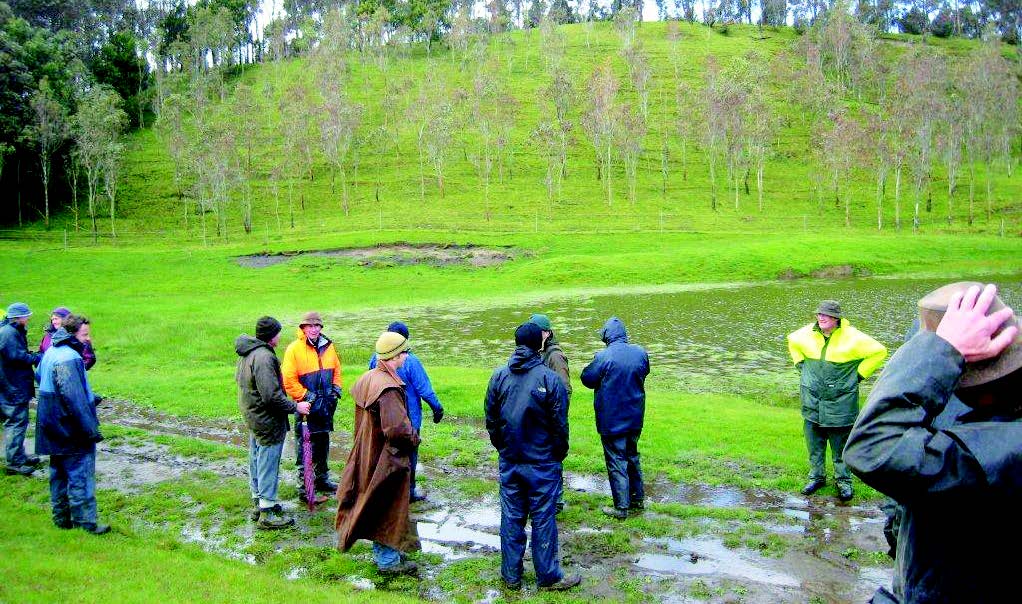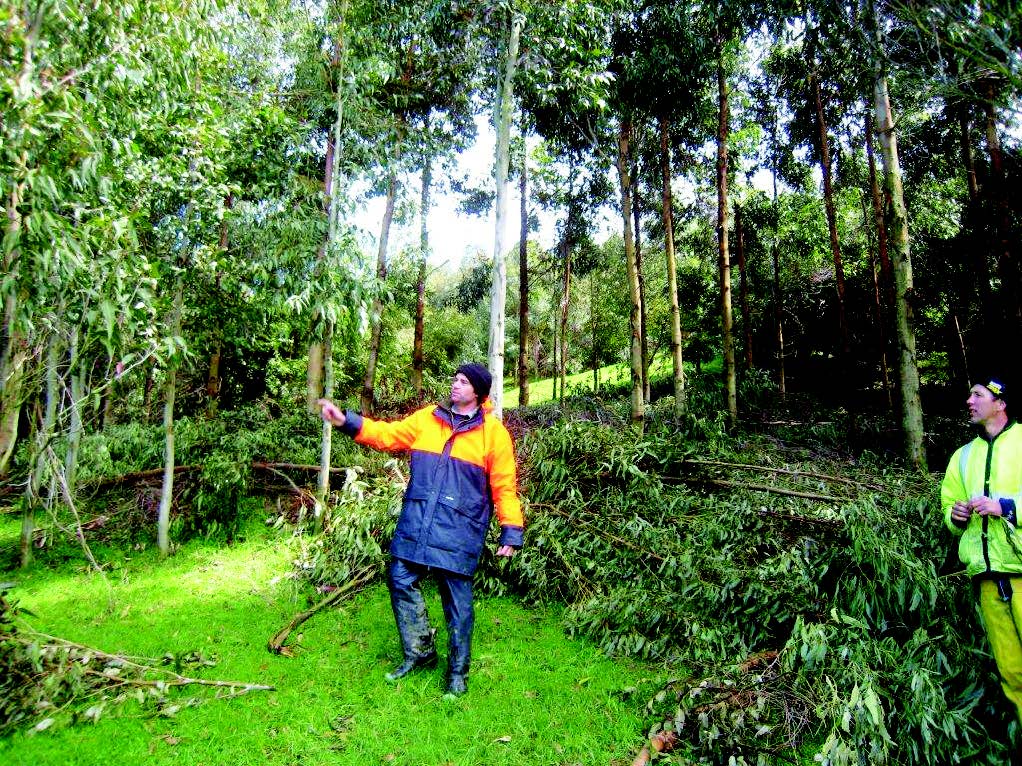Combined Action Group weekend a great educational choice
Ian Brown and Dean Satchell, New Zealand Tree Grower February 2010.
The Hawkes Bay group were hosts for the combined action group weekend in October last year. The field day focussed mainly on eucalypts and redwood.
Eucalypts
We visited the McNeil property near the coast at Waimaramara. This is a 240 hectare farm that has been in the family since 1912, and is now farmed organically. Two generations of McNeils have planted trees on it. The site is notable for wind and low rainfall but a three-year drought broke on the day of our visit.
To describe Ben McNeil as an enthusiast for eucalypts is an understatement. Over 20 years he has planted 50,000 seedlings across an extraordinary range of species. He has the best qualities of a farm forester – he is energetic, creative, willing to show failures as well as successes, and has a healthy disrespect for conventional wisdom. His experiences would fill a book.
The mild climate has allowed for a diverse range of durable eucalypt species. Our first stop was a stand of seven-year-old yellow stringybark E.muelleriana, tallowwood E. microcorys and grey gum E. propinqua. The yellow stringybark stood out for growth and form while the grey gums were very poor with small diameters, poor form and thin crowns eaten by bugs. The high initial stocking had been progressively thinned to leave only the well formed vigorous trees. Unfortunately the coppice growth is not being controlled by sheep and Ben is contemplating other options for controlling this.
Losers

The next stop was a stand of seven-year-old flooded gum E. grandis, and E. saligna, which provided a fascinating reality check on the limitations we have in New Zealand regarding species and pests. The flooded gums were from the best improved Australian seedlines available, and growth was outstanding for the first year. Then the bugs moved in and they have not grown much since. The E. saligna, also at seven years old, have performed very well and continue to show some potential as a ‘red’ timber species. We then walked past what Ben described as his greatest disaster, a stand of forest red gum E. teretecornis, savaged by insects.
Winners
We then entered a great stand of six-year-old E. maculata, E. quadrangulata and E. microcorys.The E. quadrangulata were outstanding, leaving the E. microcorys and E. maculata way behind for growth. Form was also good. This species seems to have potential in warmer areas of Hawke’s Bay, but tortoise beetle can cause some damage and is a risk factor to consider. The timber is class 2 durable and is used for many purposes in Australia. The sapwood is resistant to lyctus borer so untreated sapwood can be included in non-durable end uses such as flooring.

The E. maculata was much slower but this species, like E. microcorys, has a habit of catching up and considering its marvellous timber qualities has some potential. The E. microcorys also looked excellent, with Ben’s high stocking keeping branching to a minimum – good form, healthy crowns and ready for a thin.
The next stop was a 17-year-old stand of southern blue gum E. maidenii, where Ian Nicholas has installed sample plots to measure growth. Ian favours this species for fast initial growth rates and moderately durable and dense timber, useful for bioenergy, pulpwood, and solid timber. Fast early growth, but high branch retention, and well behind the E. regnans of the same age. It is a fairly frost-hardy species which Ben feels has more potential on inland sites too cool for other durable species that do well on this coastal site.
The last stop was a stand of 17-year-old E. regnans, which were the largest trees for their age on the property. They had not been thinned, so stocking was high, resulting in tall trees with small diameters. The volume of logs was phenomenal, demonstrating the potential of this species for carbon forestry. Dean Satchell talked about the small diameter milling study underway with Future Forests Research, and described E. regnans as a wonderful species to mill, even with small diameters. This unthinned stand could still yield good recovery of quality timber for interior uses such as joinery, panelling and flooring. This species has had some bad press in recent years, but deserves a second look.
Ben has done his homework. His innovative trials have shown both winners, and species to avoid, and will be of real benefit both to local growers, and to the farm forestry community.
Redwoods
On Sunday the skies cleared, and we went to Tutira to look at redwoods. The block is close to the lake, and adjacent to the arboretum named for Herbert Guthrie-Smith, the supreme chronicler of New Zealand farming history. Redwoods were planted by the American owner in 1998, and the land was incorporated into the arboretum several years later. In 2004, Scion and the NZ Forestry Co. jointly established a thinning and pruning trial, one of five on different sites. Members from both groups and the NZ Redwood Co. were present, and this led to some well informed discussion. Paul Silcock introduced us to the trial.
Thinning
Three thinning regimes have been applied. Thinning was not complete and it will be some time before firm recommendations can be given.
There was general agreement on a target of about 500 final crop trees per hectare when grown for timber. It was agreed that these should be clones, selected for vigour and form as well as for wood properties, which include durability, colour and density. A number of clones are now available. Two alternative regimes were suggested −
- Plant 500 trees per hectare at final spacing, without additional trees. This involves lower costs, less time, and avoids the need for thinning and the management of coppice, and gives easy access. However there is no margin for error. It demands good well prepared sites, weed control, low mortality, and careful attention to pruning, and the control of epicormics.
- Alternatively plant in rows, with intervening rows of seedlings. This is safer option, allowing gaps to be filled, with better control of branch size and epicormics.
When grown for carbon storage there might be a case for closer planting. Redwoods are shade tolerant, and this trial showed no reduction in diameter, at least at an early stage, with heavier stocking.
Pruning
Three pruning intensities using callipers were tested, and this part of the trial has been completed. Heavy pruning using a five centimetre calliper had adverse effects. There was minor loss in height, but a very significant reduction in diameter, equivalent to six months loss of growth, as well as a heavy crop of epicormics. Moderate pruning had no significant effect on height, a minor reduction in diameter, and few epicormics.
The suggested regime is to use a 10 cm to 12 cm calliper and not to remove more than 40 per cent of the foliage at one session.
The Americans do not prune their redwoods so why prune? Are we being obsessive, and following a compulsion of New Zealand foresters, which is to prune everything? That may be so, but there is a good case for pruning redwoods. The American market, which is where most of our redwood timber will go, pays a premium for clearwood, although it could be argued that the price differential might fall as supplies increase. Perhaps as important, it helps with the problem of dead branches.
Dead branches in redwoods are bad news for two reasons. First, they result in bark-encased knots, which develop at between three to six years after branch death, and this leads to a major loss of timber value. Second, they allow the entry of boring insects, which we have and the Americans do not, and these can burrow unsuspected into the heartwood. Above the pruned segment dead branches will need to be controlled by timely thinning.
Epicormics
Epicormics can lead to persistent branches, with loss in timber value. They are influenced by four factors −
- Light which can be controlled by closer spacing or interplanting
- Pruning which in this trial was much more significant in stimulating epicormics than wide spacing.
- The season of pruning, where preliminary studies suggest that autumn pruning is best in reducing epicormics
- Genetics influence epicormic production and this could be considered when selecting trees for clonal propagation.
The trees on this site are next to a highway. At present they are providing valuable information on forest management but in the future they could be a tourist attraction.
At the conclusion of this visit we are left with some clear impressions.
There is an excellent spirit of cooperation between the main players, The New Zealand Redwood Company, NZ Forestry Company and Scion. All are closely linked to the Sequoia Group, so farm foresters are very much in the loop.
The extent and quality of research in redwood, which has been initiated within the last few years, is remarkable.
The research results are being freely released to redwood growers which is clearly in everyone’s interest. We will share a common market in the US, where there will be room for all of us, and it is essential that the product we send there is of high quality. For that we need access to the best information on silvicultural management, and improved clonal material.
Tangoia Soil Conservation Reserve
Located within this 350 hectare reserve, and adjacent to the highway is a small plantation of redwoods. These were planted in 1952 with the objective of stabilising the soil next to the road. Over 50 years later, and after much of the East Coast soils have been swept away by landslides, redwoods are now being reconsidered for the same purpose.
Joe Davenport gave a fascinating description of the geology and history of the site. It has been controlled by a bewildering sequence of bureaucratic agencies. This is fortunate because in the resultant confusion no one has felt tempted to fell the redwoods. Meanwhile, they have remained under Joe’s protective care.
Macrocarpa
Across the road we passed a group of untidy black walnuts, in need of pruning and thinning, and then on to what we understood to be a 25-year-old plantation of macrocarpa. Some had been previously milled and sold as macrocarpa but the trees showed some unusual features. Although unthinned and pruned too late, the stems were straight and showed no buttressing, the foliage was atypical, the cones were a bit small, and they were canker-free. Were these the new master clones of macrocarpa? Not exactly, simply a case of mislabelling. Several sharp-eyed members of the group promptly identified them as lusitanica.
We ended the day on a high note, with a robust debate on cypress. Don Tantrum and Denis Hocking favour long rotations and low stocking to produce fat butt logs. This will provide a high proportion of clear heart, which fetches a market premium. Ian Nicholas discussed market values and the premium for heartwood.
Dean Satchell felt that thinning to low stocking for long rotations carries an unacceptable risk of windthrow. He questioned whether a longer rotation focussing on clear heartwood will produce a greater return to the grower than a simpler volume production regime based on a shorter rotation. This brought about discussion on green versus black knots, and when this transition occurs. According to Ian, bark encasement begins about five years after branch death.

 Farm Forestry New Zealand
Farm Forestry New Zealand